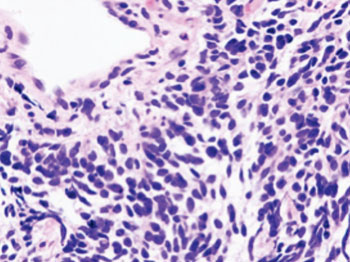Mouse Explants Generated from Patients' Circulating Tumor Cells Pave Way for Directed Personalized Chemotherapy
By LabMedica International staff writers
Posted on 19 Jun 2014
Cancer researchers have isolated circulating tumor cells (CTCs) from patients with small-cell lung cancer (SCLC) and implanted them into immunocompromised mice to use as a model system for developing better treatments for the disease.Posted on 19 Jun 2014
SCLC is an aggressive neuroendocrine tumor with early dissemination and poor prognosis that accounts for 15%–20% of lung cancer cases and approximately 200,000 deaths in the United Kingdom each year. Most cases are inoperable, and biopsies to investigate SCLC biology are rarely obtainable. A more promising approach for studying SCLC is by collecting "liquid biopsy" specimens—CTCs, which are prevalent in the blood of SCLC patients.

Image: Histopathologic image of small-cell lung cancer (Photo courtesy of Wikimedia Commons).
Investigators at the University of Manchester (United Kingdom) reported in June 1, 2014, online edition of the journal Nature Medicine that CTCs from SCLC patients who either responded to chemotherapy or failed to respond to chemotherapy developed into tumors in immunocompromised mice. The resultant CTC-derived explants (CDXs) mirrored the donor patient's response to platinum and etoposide chemotherapy. Genomic analysis of isolated CTCs revealed considerable similarity to the corresponding CDX.
Senior author Dr. Caroline Dive, professor of pharmacology and pharmacy at the University of Manchester, said, “Access to sufficient tumor tissue is a major barrier to fully understanding the biology of SCLC. This liquid biopsy is straightforward and not invasive so can be easily repeated and will allow us to study the genetics of each lung cancer patient’s individual tumor. It also means that we may have a feasible way of monitoring patient response to therapy, hopefully allowing us to personalize and tailor individual treatment plans to each patient. We can use these models to help us understand why so many SCLC patients acquire resistance to chemotherapy and to search for and test potential new targeted treatments.”
Related Links:
University of Manchester













